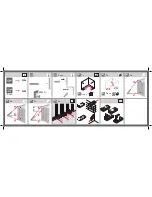
C-4
IEEE-488 Bus Overview
Models 2510 and 2510-AT User’s Manual
There are two categories of controllers: system controller and basic controller. Both are
able to control other instruments, but only the system controller has the absolute authority
in the system. In a system with more than one controller, only one controller may be active
at any given time. Certain protocol is used to pass control from one controller to another.
The IEEE-488 bus is limited to 15 devices, including the controller. Thus, any number of
talkers and listeners up to that limit may be present on the bus at one time. Although sev-
eral devices may be commanded to listen simultaneously, the bus can have only one active
talker, or communications would be scrambled.
A device is placed in the talk or listen state by sending an appropriate talk or listen com-
mand. These talk and listen commands are derived from an instrument’s primary address.
The primary address may have any value between 0 and 31, and is generally set by rear
panel DIP switches or programmed from the front panel of the instrument. The actual lis-
ten address value sent out over the bus is obtained by ORing the primary address with
#H20. For example, if the primary address is #H16, the actual listen address is #H36
(#H36 = #H16 + #H20). In a similar manner, the talk address is obtained by ORing the pri-
mary address with #H40. With the present example, the talk address derived from a pri-
mary address of 16 decimal would be #H56 (#H56 = #H16 + #H40).
The IEEE-488 standards also include another addressing mode called secondary address-
ing. Secondary addresses lie in the range of #H60-#H7F. Note, however, that many
devices, including the Model 2510, do not use secondary addressing.
Once a device is addressed to talk or listen, the appropriate bus transactions take place. For
example: if the instrument is addressed to talk, it places its data string on the bus one byte
at a time. The controller reads the information and the appropriate software can be used to
direct the information to the desired location.
Summary of Contents for TEC SourceMeter 2510
Page 194: ...A Specifications...
Page 197: ...B StatusandErrorMessages...
Page 206: ...C IEEE 488BusOverview...
Page 221: ...D IEEE 488andSCPI ConformanceInformation...
Page 225: ...E ExamplePrograms...
Page 233: ...F GPIB488 1Protocol...
















































